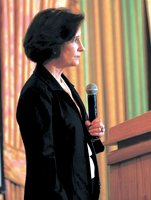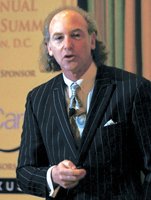AAFA Summit: Eyes on the Future in D.C.
WASHINGTON, D.C.—With politics on the agenda and setting the scene, the American Apparel & Footwear Association hosted its 2010 Executive Summit in its hometown, Washington, D.C.
Member companies—including Ann Taylor, VF Corp., Kellwood Co. and Jones Apparel Group—turned out for the March 10–12 event at the Four Seasons hotel to discuss the apparel industry’s future—and to get an insider’s view of how the nation’s capital does business.
“The last two years economically to our industry have been challenging,” said Kevin M. Burke, AAFA’s president and chief executive officer. “We thought, ’Let’s bring our meeting to our sandbox.’”
The schedule included plenty of beltway fare, including debates between former Senators Trent Lott and John Breaux and political pundits Tucker Carlson and Paul Begala and a performance by satirical group The Capitol Steps.
Several speakers—including Carlos Gutierrez, former chief executive officer and chairman of the board for Kellogg Co. and former secretary of the U.S. Department of Commerce; U.S. Trade Representative Ron Kirk; and Iris M. Tenenbaum, chair of the U.S. Consumer Product Safety Commission—addressed current hot-button issues for the apparel industry, including enforcement of the Consumer Product Safety Improvement Act and pending free-trade agreements with Colombia, Panama and Korea.
“This is an industry that eats and breathes free trade,” Burke said.
There was also a focus on several key apparel-industry issues, notably the current retail landscape seen through the eyes of executives at Costco, HSN and Mango, as well as a rousing speech about industry opportunities by The NPD Group Chief Industry Analyst Marshal Cohen, who urged the crowd to re-evaluate the traditional retail model.
“We’ve been doing the same thing for 500 years,” he said. “We’ve gotten caught up. It’s time to innovate.”Focus on trade
For former Commerce Secretary Gutierrez, the biggest issue facing the nation is the budget deficit.
“We’ve got some long-term problems, but unless we fix the deficit, it’s all not going to work,” he said. “Our deficit, as a percent of [gross domestic product], is the biggest we’ve had since World War II.”
The former commerce secretary noted that the United States’ deficit is the third highest, behind the United Kingdom and Spain. At $651.6 billion, the U.S. deficit is nearly 11 percent of the GDP. The fourth-highest is Greece, whose economy has been struggling with a deficit of nearly 13 percent of its GDP.
“Our budget deficit is higher than Greece. Think about that,” he said.
Gutierrez offered three possible solutions for fixing the deficit: raise taxes, cut spending or grow the economy.
“There are no easy answers,” he said.
Also looming are the pending trade agreements with Colombia, Panama and South Korea.
“I’m concerned about trade,” he said. “What I see is we’re standing still. And when you stand still, you fall behind.”
Kirk praised the attendees because “you understand the potential of international trade.”
“While consumers don’t know where their clothing comes from, they do know the benefits of reducing barriers and trade liberalization,” he said, adding that consumers need to understand that international trade can be a tool for job creation in the United States.
Kirk said the Obama administration is looking to open market access abroad with a goal of doubling exports in the next two years.
“When I travel outside the U.S., it is incredible how powerful the ’Made in the U.S.A.’ label is,” he said. We’re looking for new opportunities to expand the universe of those who can export.”
But Burke pointed out that many American apparel makers are less concerned with export opportunities than they are with easing import restrictions.
“We are an industry of importers,” he said. “It’s our argument that imports are as important as exports.”
Restricting recalls
CPSC chair Tenenbaum, who took office last year, described 2007 as the “year of the recall,” referring to the proliferation of recalled products following the implementation of the CPSIA, which requires testing of all children’s products for lead content.
“After all the recalls announced by CPSC in 2007, we had to restore consumer confidence in buying products that would not harm them or their children,” Tenenbaum said. “To do that, we got an increased budget and are hiring more staff, but even as our agency grows, we understand that we cannot do this job alone. We must engage effective partners. For that reason, I took several steps, including a major public outreach to businesses in a spirit of creating effective partnerships.”
The CPSC chair pledged to work with apparel makers to resolve issues regarding enforcement of CPSIA, create global standards for labeling requirements, work with manufacturers on component testing requirements, and oversee the identification and testing of nanomaterials.
“So that we never again have the year of the recall, let’s continue to work together to put the interests of consumers above all else,” she said. “Our common goal should be to make sure these problems don’t happen in the first place. We want you to build safety into your design.” Retail redux
The economic downturn has forced consumers to re-evaluate their spending, Cohen said.
“The consumer today is basing purchasing decisions on what they need—not just what they desire,” he said. “Consumers today are not running into stores; they’re running away.”
Cohen suggested companies no longer consider the five-year plan but begin planning in three-year increments or less. Companies should look to when consumers are shopping most (Friday through Sunday) and study who is really making the purchasing decisions at retail.
“Thirteen to 17-year-olds represent 13 percent of the apparel market,” he said. “But only 7 percent of teen-agers are buying it. Mom is very much a part of the equation when it comes to [selling to teens]. How many of you market to Mom?”
The growing popularity of online sample-sale Web sites underscored another of Cohen’s points: The lure of the one-day sale or “act now” sales opportunities.
He called it the “ice cream theory,” explaining, “Are you going to take it home and eat it there? Or are you going to enjoy it now? That’s the ’act now.”’
Event organizers offered three dramatically different retail scenarios in the panel discussion titled “Retail Landscape.”
With $70 billion in annual sales, 566 warehouse stores and 145,000 employees, Costco is a retail powerhouse. The company operates 16 buying offices around the world and is the third-largest retailer in the United States and the ninth-largest in the world.
Thirty million households pay a fee to be Costco members. According to Christine Summers, director of product safety and quality assurance for Costco Wholesale Inc., members expect Costco products to meet high-level quality and safety standards.
“At Costco, we try to keep safety visible,” she said, explaining the company’s rigorous quality-control methods.
HSN’s reach is similarly wide-ranging—the home-shopping channel and online side reach 94 million homes—but its business model is quite different.
The retailer sells exclusive product within a limited time window—yet it carries no inventory and no “price-point ceiling,” said Lynne Ronon, executive vice president, merchandising, for HSN.
The 32-year-old company has seen growth in all product categories, according to Ronon. The network and Web site capitalize on instant gratification by offering season-appropriate merchandise for immediate delivery.
“We can bring immediate solutions at a time [the customer] needs it,” Ronon said.
Jewelry represents 15 percent of HSN’s merchandise, followed by fashion at 11 percent. The lion’s share of the mix is home deacute;cor at 55 percent and health and beauty at 19 percent. Ronon said the company plans to expand fashion, jewelry and beauty to 50 percent of HSN’s offerings.
Rounding out the retail perspective was Jose Gomez, senior vice president, business development, for Spanish fast-fashion retailer Mango.
“Our vision is to be present in every city in the world,” Gomez said. The privately held company generates $2.3 billion in revenue and employs 8,000 people. Gomez outlined the company’s history from 1984, when it opened its first store in Barcelona, to today, when it operates 1,400 stores around the world. In 2008, the company expanded into menswear with its HE by Mango stores. The company delivers its fashion in a lightning-fast three-week design and production cycle and produces capsule collections tailored for unexpected climate changes in certain regions. Mango venues range from free-standing stores to mall stores, in-store concessions and airport stores.
“Airports in Europe are becoming shopping malls,” Gomez said. Politics unusual
Senators Breaux and Lott discussed the current political climate in Washington, D.C.
“The atmosphere in this city is about as bad as I’ve seen it, Lott said, noting that politicians on opposite sides of the aisle rarely speak to each other.
“How would your companies work if the people in charge never talked to each other?” Breaux added, recalling his years in the Senate, when representatives from the two parties were friendly adversaries. “It’s very difficult to poke someone in the eye if you had dinner with him the night before,” he said.
The two praised the AAFA for having active representation in the political process.
“So much of what happens in this city affects your industry,” Beaux said. “You have to be involved in helping to shape legislation. The atmosphere we have in our city right now is pretty poisonous in terms of getting things done.” But the camaraderie between liberal pundit Begala and conservative pundit Carlson belied the notion that Washington politics were rancorous.
Carlson is the former host of CNN’s “Crossfire” and currently a political commentator for Fox News. Begala, who served as a political strategist and counselor for President Bill Clinton, is currently a political analyst and commentator for CNN.
Carlson noted his and Begala’s political differences, joking, “It’s possible we’ll have a fist fight.”
Begala fired back with: “Whenever I follow Tucker, I feel like a mosquito at a nudist colony. It’s probably a bad idea to tell nudist jokes to the apparel community—my bad.”

























